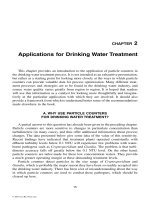understanding your users a practical guide to user requirements methods tools and techniques
Bạn đang xem bản rút gọn của tài liệu. Xem và tải ngay bản đầy đủ của tài liệu tại đây (13.38 MB, 810 trang )
TeAM
YYePG
Digitally signed by TeAM YYePG
DN: cn=TeAM YYePG, c=US,
o=TeAM YYePG, ou=TeAM
YYePG, email=
Reason: I attest to the accuracy
and integrity of this document
Date: 2005.02.21 05:07:02 +08'00'
Critical acclaim for
Understanding Your Users
A Practical Guide to User Requirements Methods, Tools, and Techniques
I wish I'd had this book ten years ago; it would have saved me an awful lot of time. It's the
kind of eminently practical guide that I really appreciate, and the case studies are excellent. I
highly recommend it!
—Steve Krug, author of Don't Make Me Think!
A Common Sense Approach to Web Usability
Courage and Baxter propel the reader to the beating heart of user-centered design with this
comprehensive and practical compendium of process, methodology, and cutting-edge
thinking. The techniques they explain so clearly in this detailed and thorough book provide
the power to expose the common myth, opinion, and misunderstanding, and reveal the
authentic nature of the true engine of wealth in the information age: your users; the people
who use your digital systems.
—Alan Cooper, Founder & Chairman of the Board, Cooper
Here's a book that could easily become your best friend, whether you're just starting out or
are a seasoned professional.
Courage and Baxter cover it all, from hard science to ethics to the finest practical details.
You'll find a wealth of case studies and instantly accessible answers to sudden questions—
"My test subject just refused to be video taped. What do I do?" —along with many valuable
techniques that will be new even to seasoned interaction designers and usability professionals,
techniques that I began applying immediately in my own work.
—Bruce "Tog" Tognazzini, Principal, Nielsen/Norman Group
This is a detailed, step-by-step guide to user requirements gathering, one of the most critical,
yet often overlooked stages in product development research. Courage and Baxter effectively
draw on real-world experience as well as tried-and-true methods.
—Christian Rohrer, Director, User Experience Research, Yahoo!
UUAPR 9/18/04 2:24 PM Page i
Modestly presented as a "how to" book, this work is much more. It helps to consolidate the
new field of interaction design by focusing on a common-sense approach to user research.
This is an immensely practical book with enduring value for the interaction designer and the
usability professional.With detailed discussions of seven key methods of study, clear examples,
well-chosen supporting case studies, and an assessment of the proper use of each method,
Courage and Baxter have provided an intelligent pathway for those new to the field and a
reference work for experienced professionals. The added benefit—in effect, illustrating the very
philosophy of user-centered design that they advance—is the way the authors have placed
usability study in a wider context of what comes before and after one studies users. This is a
thoroughly accessible and usable book. It may well become a classic of the field.
—Richard Buchanan, Ph.D., Professor, Carnegie Mellon
University and President, Design Research Society
Effectively gathering and applying user requirements is one of the most critical areas of focus
in today's companies. This invaluable resource provides comprehensive and practical
guidance on a variety of methods—including strategies, tactics, tips, and templates—
enabling readers to more efficiently apply techniques in their own organizations.
—Janice Rohn, Vice President, User Experience, World Savings Bank
In Understanding Your Users, Catherine and Kathy give usability practitioners a
thorough and practical handbook for conducting user research. They provide details necessary
for planning, preparing, conducting, analyzing, and presenting the research for a variety of
techniques. Their insights and advice on what to do when something unexpected occurs will
be particularly invaluable for those just starting out their careers in user research or those
interested in trying out an unfamiliar user research technique.
Peppered with checklists, case studies, and practical advice offered in this book, you will
immediately increase your ability to conduct user research that yields quality and reliable
results.
—Pawan Vora, Principal, Inov Information Designs
UUAPR 9/18/04 2:24 PM Page ii
UNDERSTANDING
YOUR USERS
A Practical Guide to User Requirements
Methods, Tools, and
Techniques
UUAPR 9/18/04 2:24 PM Page iii
The Morgan Kaufmann Series in Interactive Technologies
Series Editors: Stuart Card, PARC; Jonathan Grudin, Microsoft; Jakob Nielsen, Nielsen Norman Group
Understanding Your Users: A Practical Guide to User
Requirements Methods, Tools, and Techniques
Catherine Courage and Kathy Baxter
The Web Application Design Handbook: Best
Practices for Web-Based Software
Susan Fowler and Victor Stanwick
The Mobile Connection: The Cell Phone’s Impact on
Society
Richard Ling
Information Visualization: Perception for Design, 2nd
Edition
Colin Ware
Interaction Design for Complex Problem Solving:
Developing Useful and Usable Software
Barbara Mirel
The Craft of Information Visualization: Readings and
Reflections
Written and edited by Ben Bederson and
Ben Shneiderman
HCI Models, Theories, and Frameworks: Towards a
Multidisciplinary Science
Edited by John M. Carroll
Web Bloopers: 60 Common Web Design Mistakes,
and How to Avoid Them
Jeff Johnson
Observing the User Experience: A Practitioner’s Guide
to User Research
Mike Kuniavsky
Paper Prototyping: The Fast and Easy Way to Design
and Refine User Interfaces
Carolyn Snyder
Persuasive Technology: Using Computers to Change
What We Think and Do
B. J. Fogg
Coordinating User Interfaces for Consistency
Edited by Jakob Nielsen
Usability for the Web: Designing Web Sites that Work
Tom Brinck, Darren Gergle, and Scott D.Wood
Usability Engineering: Scenario-Based Development of
Human-Computer Interaction
Mary Beth Rosson and John M. Carroll
Your Wish is My Command: Programming by
Example
Edited by Henry Lieberman
GUI Bloopers: Don’ts and Dos for Software
Developers and Web Designers
Jeff Johnson
Information Visualization: Perception for Design
Colin Ware
Robots for Kids: Exploring New Technologies for
Learning
Edited by Allison Druin and James Hendler
Information Appliances and Beyond: Interaction
Design for Consumer Products
Edited by Eric Bergman
Readings in Information Visualization: Using Vision
to Think
Written and edited by Stuart K. Card, Jock D.
Mackinlay, and Ben Shneiderman
The Design of Children's Technology
Edited by Allison Druin
Web Site Usability: A Designer’s Guide
Jared M. Spool, Tara Scanlon, Will Schroeder,
Carolyn Snyder, and Terri DeAngelo
The Usability Engineering Lifecycle: A Practitioner's
Handbook for User Interface Design
Deborah J. Mayhew
Contextual Design: Defining Customer-Centered
Systems
Hugh Beyer and Karen Holtzblatt
Human-Computer Interface Design: Success Stories,
Emerging Methods, and Real World Context
Edited by Marianne Rudisill, Clayton Lewis, Peter
P. Polson, and Timothy D. McKay
UUAPR 9/18/04 2:24 PM Page iv
UNDERSTANDING
YOUR USERS
A Practical Guide to User Requirements
Methods, Tools, and
Techniques
Catherine Courage and Kathy Baxter
AMSTERDAM • BOSTON • HEIDELBERG • LONDON
NEW YORK • OXFORD • PARIS • SAN DIEGO
SAN FRANCISCO • SINGAPORE • SYDNEY • TOKYO
Morgan Kaufmann Publishers is an imprint of Elsevier
UUAPR 9/18/04 2:24 PM Page v
Publishing Director Diane D. Cerra
Publishing Services Manager André Cuello
Editorial Coordinator Mona Buehler
Project Manager Anne B. McGee
Cover Design Uday Gajendar
Cover Image Getty Images
Text Design Yvo Riezebos Design
Composition SNP Best-set Typesetter, Ltd.
Illustration Dartmouth Publishing, Inc.
Copyeditor Keyword Publishing Services Ltd.
Proofreader Keyword Publishing Services Ltd.
Indexer Keyword Publishing Services Ltd.
Interior printer Hing Yip Printing Co., Ltd.
Cover printer Hing Yip Printing Co., Ltd.
Morgan Kaufmann Publishers is an imprint of Elsevier.
500 Sansome Street, Suite 400, San Francisco, CA 94111
This book is printed on acid-free paper.
© 2005 by Elsevier Inc. All rights reserved.
Designations used by companies to distinguish their products are often claimed as trademarks or registered trademarks. In
all instances in which Morgan Kaufmann Publishers is aware of a claim, the product names appear in initial capital or all
capital letters. Readers, however, should contact the appropriate companies for more complete information regarding
trademarks and registration.
No part of this publication may be reproduced, stored in a retrieval system, or transmitted in any form or by any means—
electronic, mechanical, photocopying, scanning, or otherwise—without prior written permission of the publisher.
Permissions may be sought directly from Elsevier’s Science & Technology Rights Department in Oxford, UK: phone: (+44)
1865 843830, fax: (+44) 1865 853333, e-mail: You may also complete your request on-line via the
Elsevier homepage () by selecting “Customer Support” and then “Obtaining Permissions.”
Library of Congress Cataloging-in-Publication Data
Application submitted.
ISBN: 1-55860-935-0
For information on all Morgan Kaufmann publications, visit our Web site at www.mkp.com or www.books.elsevier.com
Printed in China
0405060708 54321
UUAPR 9/18/04 2:24 PM Page vi
CONTENTS
vii
Preface xxiii
Acknowledgments xxvii
PART 1 WHAT YOU NEED TO KNOW BEFORE CHOOSING AN
ACTIVITY 1
1
INTRODUCTION TO USER REQUIREMENTS 2
Introduction 3
User-centered Design 3
Principles of User-centered Design 4
Incorporating User-centered Design Principles into the
Product Lifecycle 6
A Variety of Requirements 8
The Product Team’s Perspective 9
User Requirements 13
UUAPR 9/18/04 2:24 PM Page vii
Getting Stakeholder Buy-in for Your Activity 14
Arguments and Counter Arguments 15
Preventing Resistance 18
The Methods 21
2
BEFORE YOU CHOOSE AN ACTIVITY: LEARNING
ABOUT YOUR PRODUCT AND USERS 28
Introduction 29
Learn About Your Product 29
Learn About Your Users 41
Step 1: User Profile 43
Step 2: Personas 47
Step 3: Scenarios 52
Pulling It All Together 59
Case Study A: Competitive Intelligence: Mining
Design Concepts from Business School
Libraries 59
Case Study B: Personas: A Case Study by Microsoft
Corporation 75
3
ETHICAL AND LEGAL CONSIDERATIONS 94
Introduction 95
Ethical Considerations 95
The Right To Be Informed 97
Permission to Record 99
CONTENTS
viii
UUAPR 9/18/04 2:24 PM Page viii
Create a Comfortable Experience 99
Appropriate Language 99
Anonymity 100
The Right To Withdraw 100
Appropriate Incentives 100
Valid and Reliable Data 101
Acknowledge Your True Capabilities 101
Data Retention and Documentation 102
Debrief 102
Legal Considerations 103
Pulling It All Together 104
4
SETTING UP FACILITIES FOR YOUR USER
REQUIREMENTS ACTIVITY 106
Introduction 107
Using Your Company’s Existing Facilities 108
Renting a Marketing or Hotel Facility 110
Building a Permanent Facility 111
Components of a Devoted User Requirements
Facility 112
Lab Layout 123
Digital versus Analog Labs 126
Analog Recording 127
Digital Recording 128
Pulling It All Together 129
CONTENTS
ix
UUAPR 9/18/04 2:24 PM Page ix
Case Study: Designing an Innovative Cost-effective
Usability Lab 129
PART 2 GET UP AND RUNNING 143
5
PREPARING FOR YOUR USER REQUIREMENTS
ACTIVITY 144
Introduction 145
Creating a Proposal 146
Why Create a Proposal? 146
Sections of the Proposal 147
Sample Proposal 149
Getting Commitment 153
Deciding the Duration and Timing of Your
Session 155
Recruiting Participants 156
How Many Participants Do I Need? 157
Determining Participant Incentives 159
Developing a Recruiting Screener 161
Sample Screener 166
Creating a Recruitment Advertisement 169
Sample Posting 172
Recruitment Methods 173
Preventing No-shows 182
Recruiting International Participants 184
Recruiting Special Populations 186
CONTENTS
x
UUAPR 9/18/04 2:24 PM Page x
Tracking Participants 188
Tax Implications 188
The Professional Participant 189
Create a Watch List 190
Creating a Protocol 191
Piloting Your Activity 193
Pulling It All Together 196
Case Study: Cultural Differences Affecting User
Research Methods in China 196
6
DURING YOUR USER REQUIREMENTS ACTIVITY 208
Introduction 209
Welcoming Your Participants 209
Dealing with Late and Absent Participants 211
The Late Participant 211
You Can’t Wait Any Longer 212
Including a Late Participant 214
The No-show 215
Warm-up Exercises 215
Inviting Observers 216
Introducing Your Think-aloud Protocol 218
Moderating Your Activity 220
Recording and Note-taking 226
CONTENTS
xi
UUAPR 9/18/04 2:24 PM Page xi
Dealing with Awkward Situations 230
Participant Issues 232
Product Team/Observer Issues 241
Pulling It All Together 244
PART 3 THE METHODS 245
7
INTERVIEWS 246
Introduction 247
When Should You Conduct Interviews? 248
Things To Be Aware of When Conducting
Interviews 250
Outcomes Analysis 252
Preparing to Conduct an Interview 256
Identify the Objectives of the Study 258
Select the Type of Interview 258
Decide Now How You Will Analyze the Data 262
Write the Questions 262
Test Your Questions 270
Players in Your Activity 270
Inviting Observers 273
Activity Materials 274
Conducting an Interview 274
The Five Phases of an Interview 275
Your Role as the Interviewer 277
Monitoring the Relationship with the Interviewee 290
Dos and Don’ts 292
CONTENTS
xii
UUAPR 9/18/04 2:24 PM Page xii
Data Analysis and Interpretation 293
Categorizing 294
Affinity Diagram 294
Qualitative Analysis Tools 294
Communicate the Findings 295
Lessons Learned 297
Pulling It All Together 298
Case Study: Preparing and Conducting On-site
Interviews 299
8
SURVEYS 312
Introduction 313
When Should You Use a Survey? 314
Things To Be Aware of When Using a Survey 315
Creating and Distributing Your Survey 316
Preparation Timeline 317
Identify the Objectives of Your Study 319
Players in Your Activity 319
Compose Your Questions 320
Determine Now How You Will Analyze Your Data 333
Building the Survey 335
Considerations When Choosing a Survey Distribution
Method 338
Distributing Your Survey via the Web, E-mail, or
Paper 343
Test Your Survey 346
CONTENTS
xiii
UUAPR 9/18/04 2:24 PM Page xiii
Data Analysis and Interpretation 348
Initial Assessment 348
Types of Calculation 349
Communicate the Findings 357
Lessons Learned 358
Pulling It All Together 359
Case Study: Using Online Surveys to Quantify
Usability Issues 359
9
WANTS AND NEEDS ANALYSIS 370
Introduction 371
When Should You Conduct a Wants and Needs
Analysis? 372
Things To Be Aware of When Conducting a Wants
and Needs Analysis 372
Preparing for a Wants and Needs Analysis 374
Preparation Timeline 375
Identify the Brainstorming Question 376
Players in Your Activity 378
Inviting Observers 380
Activity Materials 381
Conducting a Wants and Needs Analysis 381
Welcome the Participants 382
Introduce the Activity and Brainstorming Rules 382
Have a Practice Exercise 384
CONTENTS
xiv
UUAPR 9/18/04 2:24 PM Page xiv
The Brainstorming 385
Prioritization 387
Data Analysis and Interpretation 392
Create Identifiers for Each Booklet 393
Sort Based on Verbatim Content 393
Combine Groups 394
Remove Duplicates from Each Pile 395
Determine the Percentage of Respondents Per
Group 396
Combine Data from Multiple Sessions 396
Interpreting the Data 398
Communicate the Findings 399
Modifications 401
Lessons Learned 407
Pulling It All Together 408
Case Study: Understanding Users’ Healthcare Wants
and Needs 409
10
CARD SORTING 414
Introduction 415
When Should You Conduct a Card Sort? 416
Things To Be Aware of When Conducting a Card
Sort 417
Group or Individual Card Sort? 417
CONTENTS
xv
UUAPR 9/18/04 2:24 PM Page xv
Preparing to Conduct a Card Sort 418
Preparation Timeline 419
Identify Objects and Definitions for Sorting 420
Activity Materials 422
Additional Data Collected in a Card Sort 424
Players in Your Activity 426
Inviting Observers 427
Conducting a Card Sort 428
Activity Timeline 428
Welcome the Participants 429
Practice 429
Card Review and Sorting 430
Labeling Groups 432
Data Analysis and Interpretation 432
Analysis with a Card Sorting Program 437
Analysis with a Statistics Package 437
Analysis with a Spreadsheet Package 438
Data that Computer Programs Cannot Handle 438
Interpreting the Results 439
Communicate the Findings 442
Modifications 443
Lessons Learned 447
Pulling It All Together 447
Case Study: How Card Sorting Changed a Website
Team’s View of How the Site Should Be
Organized 447
CONTENTS
xvi
UUAPR 9/18/04 2:24 PM Page xvi
11
GROUP TASK ANALYSIS 458
Introduction 459
Background to Task Analysis 460
Overview of Group Task Analysis 462
When to Use a Group Task Analysis 463
Benefits of the Group Approach 466
Things To Be Aware of When Conducting a GTA 467
Types of Data You Can Collect 469
Preparing to Conduct a Group Task Analysis 472
Preparation Timeline 473
Determine the Task of Interest 475
Identify the Task Steps 475
Players Involved in the Activity 477
Inviting Observers 479
Activity Materials 480
Conducting a Group Task Analysis 482
Activity Timeline 482
Welcome the Participants 483
Train the Participants 484
Moderate the Group 489
Review the Task 493
Debrief 495
Data Analysis and Interpretation 495
Recreate the Flow within 24 Hours 495
Deal with Multiple Flows 497
Analyze the Data 498
CONTENTS
xvii
UUAPR 9/18/04 2:24 PM Page xvii
Communicate the Findings 501
Modifications 503
Lessons Learned 505
Pulling It All Together 507
Case Study: Capturing Task Information on
How People Prepare For and Conduct Online
Meetings 507
12
FOCUS GROUPS 514
Introduction 515
When Should You Use a Focus Group? 516
Things To Be Aware of When Conducting a Focus
Group 518
Preparing to Conduct a Focus Group 521
Preparation Timeline 522
Identify the Questions You Wish to Answer 523
Players in Your Activity 527
Inviting Observers 533
Activity Materials 533
Conducting a Focus Group 535
Activity Timeline 535
Welcome the Participants 535
Introduce the Activity and Discussion Rule 536
The Focus Group Discussion 536
CONTENTS
xviii
UUAPR 9/18/04 2:24 PM Page xviii
CONTENTS
xix
Data Analysis and Interpretation 538
Debrief 538
Analyzing Quantitative Data 538
Analyzing Qualitative Data 539
Communicate the Findings 540
Modifications 542
Lessons Learned 546
Pulling It All Together 550
Case Study: Engineering Collaborative Tools: a
Different Use 551
13
FIELD STUDIES 562
Introduction 563
When Should You Conduct Field Studies? 564
Things To Be Aware of When Conducting Field
Research 566
Field Study Methods to Choose From 569
Observation Only 573
Interacting with the User 579
Method Supplements 587
Preparing for a Field Study 591
Identify the Type of Study to Conduct 592
Players in Your Activity 593
Train the Players 598
UUAPR 9/18/04 2:24 PM Page xix
Develop your Protocol 599
Schedule the Visits 600
Activity Materials 603
Summary 607
Conducting a Field Study 608
Get Organized 609
Meet the Participant 609
Begin Data Collection 611
Wrap-up 612
Organize Your Data 612
Summary 615
Data Analysis and Interpretation 615
Debrief 617
Affinity Diagram 617
Analyzing Deep Hanging-Out Data 617
Analyzing Contextual Inquiry/Design Data 618
Analyzing Data from Discount User Observations 619
Qualitative Analysis Tools 621
Communicate the Findings 621
Lessons Learned 623
Pulling It All Together 625
Case Study: Understanding the Staples Delivery
Experience 625
CONTENTS
xx
UUAPR 9/18/04 2:24 PM Page xx
PART 4 WRAPPING UP 635
14
CONCLUDING YOUR ACTIVITY 636
Introduction 637
Prioritization of Findings 638
First Prioritization: Usability Perspective 639
Second Prioritization: Merging Usability and Product
Development Priorities 641
Presenting your Findings 644
Why the Verbal Presentation is Essential 646
Presentation Attendees 647
Ingredients of a Successful Presentation 648
Reporting Your Findings 652
Report Format 652
The Complete Report 654
The Recommendations Report 658
The Executive Summary Report 659
Report Supplements 659
Ensuring the Incorporation of Your Findings 660
Stakeholder Involvement 661
Be a Virtual Member of the Team 662
Obtain a Status for Each Recommendation 663
Ensure the Product Team Documents Your
Findings 663
Keep a Scorecard 664
Pulling It All Together 666
CONTENTS
xxi
UUAPR 9/18/04 2:24 PM Page xxi
Case Study: Calico Configuration
Modeling Workbench 666
PART 5 APPENDICES 677
A Learn About Usability 678
B Vendors that Offer Training in Usability
Activities 688
C Vendors that Consult on Usability Lab Design,
Sell or Rent Lab Equipment, or Build Labs 694
D Vendors that Recruit Participants, Conduct
Usability Activities for You, and/or Rent
Facilities to You 698
E Requirements for Creating a Participant
Recruitment Database 704
F Affinity Diagram 714
G Computerized Qualitative Analysis Tools 722
H Report Template 726
I Glossary 738
J References 750
Index 759
Figure and Table Credits 779
About the Authors 781
CONTENTS
xxii
UUAPR 9/18/04 2:24 PM Page xxii
xxiii
PREFACE
How to use this book
Usability refers to the effectiveness, efficiency, and satisfaction with which users can
achieve tasks when using a product. A usable product is easy to learn and remem-
ber; is efficient, visually pleasing, and pleasant to use; and enables users to quickly
recover from errors and accomplish their tasks with ease. In order to make a product
usable, those involved in product development must employ usability methods to
ensure optimal usability. User requirements methodologies are methods that can
be used in the early stages of product development to help fulfill this goal.
This book is designed to be an easy-to-read “how-to” guide on user requirements
gathering methods in the real world. It teaches seven distinct user requirements
gathering methods and also covers pre- and post-method considerations, such as
recruiting, facilitating group activities, negotiating with product developments
teams/customers, and getting your results incorporated into the product. To help
illustrate the material and methods presented in this book, we refer to a fictitious
travel website called “TravelSmart.com” throughout the book. In addition, we have
included real-world case studies to show how these methods have been applied in
industry.
This book has five main parts.
Part 1: What You Need to Know Before Choosing an Activity
Often people are not aware of all the factors they should consider before
choosing a requirements activity. Chapters 1 through 4 will introduce you to user
UUAPR 9/18/04 2:24 PM Page xxiii
requirements and the factors you need to consider. They cover such critical
topics as:
■
The difference between user requirements and other types of requirements
■
Getting buy-in from the product team to conduct user requirements activities
■
Product/domain research
■
Learning who your end user really is, including creating personas and
scenarios
■
Legal and ethical issues
■
Creating an environment to conduct user requirements activities.
Part 2: Get Up and Running
Once you have decided to conduct a user requirements activity, the preparation
process begins. Much of the preparation that must be done is the same regardless
of the activity that you will conduct. Chapters 5 and 6 focus on this groundwork so
that you are fully prepared to execute your activity. This work includes:
■
Creating a proposal and protocol for your activity
■
Recruiting
■
Piloting
■
Welcoming the participants
■
Moderating the activity.
Part 3: The Methods
Chapters 7 through 13 focus on user requirements gathering techniques. Each
chapter focuses on a different method and variations on that method. For each of
these methods, you will learn step by step how to prepare for the activity, conduct
the activity, and analyze the data. Materials, templates, and checklists are provided
to get you using the techniques in no time! Lessons learned and method
modifications are discussed as well so that you can adapt a method to suit your needs
and avoid making costly mistakes. The methods covered are:
■
Interviews
■
Surveys
PREFACE
xxiv
UUAPR 9/18/04 2:24 PM Page xxiv






![the game audio tutorial [electronic resource] a practical guide to sound and music for interactive games](https://media.store123doc.com/images/document/14/y/oo/medium_oon1401475551.jpg)


